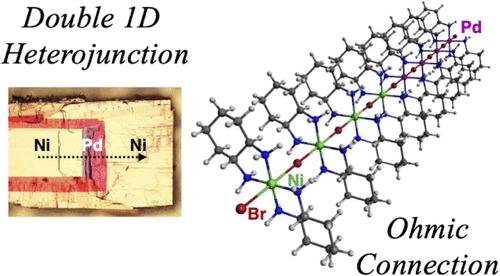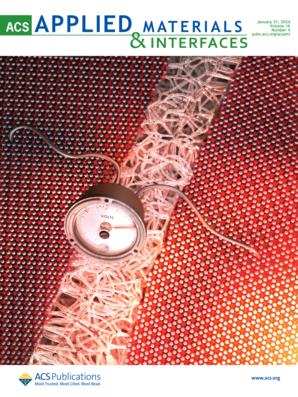Double Core–Shell Semiconducting Molecular Chain Halogen-Bridged Metal Complexes with Ohmic Contact Heterojunctions
IF 8.3
2区 材料科学
Q1 MATERIALS SCIENCE, MULTIDISCIPLINARY
引用次数: 0
Abstract
The fabrication of heterostructures from low-dimensional materials is very challenging, particularly the creation of low-dimensional heterojunctions that can be characterized at an atomic resolution. In a previous work, a two-dimensional (2D) heterostructure made from halogen-bridged metal complexes (MX-Chains), [Ni(chxn)2Br]Br2 (chxn = 1R,2R-diaminocyclohexane) and [Pd(chxn)2Br]Br2, has been synthesized, and the nature of the electronically 1D heterojunction at an atomic resolution was revealed. In the work reported here, we have successfully fabricated double core–shell crystals (Ni–Pd–Ni) from these MX-Chains, using a stepwise electrochemical epitaxial method. Upon cleavage of the heterostructure along the van der Waals layers, a double heterojunction surface is observed. The MX-Chains are aligned in the heterostructure and exhibit anisotropic optical properties based on their 1D electronic systems, as measured using UV–vis–NIR polarized reflectance microscopy. Current–voltage curves at different temperatures are recorded using three probes attached to different areas of the heterostructure and reveal the presence of ohmic conduction through the double 1D heterojunctions. The ohmic contact between the two types of MX-Chains arises from the atomic-scale connection of the MX-Chains at the heterojunction. This work represents the first example of a molecule-based heterostructure that has electronic conductivity and demonstrates electrical conduction through a 1D heterojunction.

求助全文
约1分钟内获得全文
求助全文
来源期刊

ACS Applied Materials & Interfaces
工程技术-材料科学:综合
CiteScore
16.00
自引率
6.30%
发文量
4978
审稿时长
1.8 months
期刊介绍:
ACS Applied Materials & Interfaces is a leading interdisciplinary journal that brings together chemists, engineers, physicists, and biologists to explore the development and utilization of newly-discovered materials and interfacial processes for specific applications. Our journal has experienced remarkable growth since its establishment in 2009, both in terms of the number of articles published and the impact of the research showcased. We are proud to foster a truly global community, with the majority of published articles originating from outside the United States, reflecting the rapid growth of applied research worldwide.
 求助内容:
求助内容: 应助结果提醒方式:
应助结果提醒方式:


